What is SEO Content Strategy: A Simple Guide


SEO content strategy is more than just a buzzword—it's a vital roadmap that guides your content towards better visibility and engagement. In fact, companies with a well-defined SEO strategy are 13 times more likely to see positive ROI. However, here's the kicker: many businesses still neglect strategic planning and dive straight into content creation. This can lead to misaligned efforts and wasted resources. But with the right approach, you can transform your content into a powerful tool that not only attracts traffic but also converts visitors into loyal customers.
Understanding SEO Content Strategy

An SEO content strategy is a systematic approach to creating, organizing, and promoting content that ranks well in search engines while meeting your audience's needs. At its core, a successful SEO content strategy aligns what your audience is searching for with what your business offers.
According to Moz's content strategy experts, shifting from a purely keyword-driven approach to an audience-centric strategy is crucial for long-term success. This means understanding your audience's pain points before diving into keyword research.
Components of an Effective SEO Content Strategy
- Audience Research - Understanding who you're creating content for, including their needs, problems, and search behaviors
- Competitive Analysis - Identifying content gaps your competitors aren't addressing
- Keyword Strategy - Researching and targeting relevant search terms your audience uses
- Content Planning - Developing a systematic plan for content creation, including topics, formats, and publication schedule
- Content Creation - Producing high-quality, relevant content optimized for both users and search engines
- Distribution & Promotion - Getting your content in front of your target audience
- Performance Measurement - Tracking and analyzing how your content performs against established KPIs
Unlike random content creation, a strategic SEO content approach ensures every piece serves specific business and audience objectives. For example, a SaaS company might create a comprehensive guide targeting "cloud migration solutions" after discovering this keyword has high search volume among their target audience of IT directors with purchase authority.
A well-executed SEO content strategy drives organic traffic, builds authority, generates leads, and ultimately contributes to revenue growth by connecting your business with the right audience at the right time.
Key Takeaways
| Takeaway | Explanation |
|---|---|
| Align Content with Audience Needs | Successful SEO content strategies focus on understanding and addressing the specific pain points and interests of the target audience. |
| Shift from Keywords to Audience-Centric Strategy | Focusing on the audience's needs instead of solely on keyword metrics leads to more meaningful content creation and better long-term results. |
| Implement a Systematic Approach | An effective SEO content strategy involves a structured process that includes research, planning, creation, distribution, and measurement. |
Planning Your Content Approach

Effective SEO content planning transforms your strategy from concept to reality. This systematic process ensures your content efforts align with both SEO goals and audience needs.
6 Steps to Develop Your SEO Content Plan
-
Define Clear Objectives
Determine what you want your content to achieve—whether it's increasing organic traffic, generating leads, building authority, or improving conversions. For example, a B2B software company might prioritize lead generation content like whitepapers and case studies over general awareness content. -
Create Content Categories
Organize your content into strategic buckets that address different aspects of your business and audience needs. According to Ahrefs' content planning guide, defining the "why, who, what, and where" of your content creation works like a recipe for success, providing structure to your planning process. -
Develop a Content Calendar
Schedule your content creation and publication dates to maintain consistency and accountability. Your calendar should include:- Topic/title
- Target keywords
- Content type (blog, guide, video, etc.)
- Publication date
- Assigned team members
- Status (planned, in progress, published)
-
Balance Content Types
Mix different content formats to reach your audience at various stages of their journey:- Top of funnel: Educational blog posts, infographics, videos
- Middle of funnel: Case studies, webinars, detailed guides
- Bottom of funnel: Comparison pages, testimonials, product demonstrations
-
Create Content Briefs
Develop detailed outlines for each piece of content including:- Primary and secondary keywords
- Target word count
- Key points to cover
- Competitor analysis
- Internal and external linking opportunities
-
Establish Clear Workflows
Define the process from content conception to publication, including research, writing, editing, optimization, and promotion steps.
Content Planning Tools
| Tool Type | Purpose | Example |
|---|---|---|
| Keyword Research | Identify target terms | Ahrefs, SEMrush |
| Content Calendar | Schedule production | CoSchedule, Trello |
| Analytics | Track performance | Google Analytics, Search Console |
| Collaboration | Team workflow | Asana, Monday.com |
A well-executed content plan provides direction and consistency, ensuring your SEO content strategy delivers measurable results rather than scattered, ineffective content pieces. By systematically planning what to create and when to publish it, you'll maximize resources and create content that genuinely serves both search engines and your audience.
Effective Keyword Research Methods
Keyword research forms the foundation of any successful SEO content strategy. It reveals what your audience is actually searching for and helps you discover your competitive advantage in the search landscape.
According to HubSpot's keyword research guide, effective keyword research identifies your "SEO sweet spot"—keywords that aren't too competitive to rank for while aligning with content you can create effectively.
Step-by-Step Keyword Research Process
-
Start With Seed Keywords
Begin with broad terms directly related to your business, products, or services. For example, a digital marketing agency might start with terms like "digital marketing," "SEO services," or "social media management." -
Expand Using Keyword Research Tools
Use specialized tools to discover related terms, questions, and variations:- Paid tools: Ahrefs, SEMrush, Moz
- Free alternatives: Google Keyword Planner, AnswerThePublic, Google Trends
-
Analyze Search Intent
Categorize keywords based on user intent:- Informational: Users seeking knowledge ("how to improve website SEO")
- Navigational: Users looking for specific websites ("HubSpot login")
- Commercial: Users researching before purchase ("best SEO tools comparison")
- Transactional: Users ready to buy ("buy SEO software")
-
Evaluate Keyword Metrics
Consider these factors when selecting target keywords:- Search volume: Monthly search frequency
- Keyword difficulty: Competition level
- Click-through potential: Likelihood of generating clicks
- Business relevance: Alignment with your offerings
-
Focus on Long-Tail Keywords
Long-tail keywords (3+ word phrases) typically have:- Lower competition
- Higher conversion potential
- More specific search intent
Prioritizing Keywords for Content Creation
Create a scoring system to prioritize keywords based on:
- Relevance score (1-10): How closely the keyword matches your business offerings
- Competition score (1-10): Inverse difficulty rating (easier = higher score)
- Volume score (1-10): Search volume relative to your industry
- Intent match (1-10): How well the keyword aligns with your conversion goals
Multiply these scores to identify your highest-priority keywords. For example, a small HR software company might prioritize "small business HR software solutions" (relevance: 9, competition: 7, volume: 6, intent: 8) over "HR software" (relevance: 7, competition: 2, volume: 9, intent: 5).
Effective keyword research isn't a one-time task—it's an ongoing process that evolves with changing search patterns, business priorities, and market conditions. Revisit your keyword strategy quarterly to stay aligned with current search trends and business objectives.
Creating Engaging SEO Content
Creating content that ranks well and engages readers requires balancing search engine requirements with user experience. The most successful SEO content satisfies both search algorithms and human readers by providing genuine value.
The Dual Purpose of SEO Content
According to WordStream's guide on SEO content, effective SEO content must simultaneously:
- Attract search engine traffic through strategic keyword optimization
- Deliver value to users through helpful, informative, and engaging information
Content that prioritizes only search engines typically fails to engage readers, resulting in high bounce rates that ultimately hurt rankings.
Essential Elements of High-Performing SEO Content
-
Compelling Headlines
Create titles that include your target keyword while generating interest. For example, instead of "Email Marketing Tips," use "7 Email Marketing Strategies That Doubled Our Conversion Rate." -
Structured for Readability
- Use descriptive H2 and H3 subheadings that incorporate secondary keywords
- Keep paragraphs short (3-4 sentences maximum)
- Include bullet points and numbered lists for easy scanning
- Add relevant images, charts, or infographics to break up text
-
Comprehensive Coverage
Address the topic thoroughly, answering related questions your audience might have. This approach satisfies search intent while positioning your content as an authoritative resource. -
Actionable Information
Provide specific steps, examples, or templates readers can implement immediately. For instance, a post about "improving email open rates" should include actual subject line examples that have proven successful. -
Strategic Keyword Placement
- Include your primary keyword in the title, first paragraph, at least one H2, and naturally throughout the content
- Incorporate secondary keywords in subheadings and body text
- Use related terms and synonyms to establish topical relevance
- Avoid keyword stuffing that makes content sound unnatural
Content Types That Perform Well in SEO
-
How-to Guides and Tutorials
Step-by-step instructions that solve specific problems -
List Posts
Curated collections of tips, tools, examples, or resources -
In-depth Resource Guides
Comprehensive coverage of complex topics with multiple subtopics -
Case Studies
Real-world examples with specific results and methodologies -
Expert Roundups
Featuring insights from multiple industry experts on a specific topic
Successful SEO content always prioritizes the reader's experience while strategically incorporating SEO elements. By focusing on creating genuinely helpful content that addresses your audience's needs, you'll build authority, earn natural backlinks, and achieve sustainable search visibility.
Measuring SEO Content Success
Understanding whether your SEO content strategy is delivering results requires a systematic approach to measurement. Tracking the right metrics helps you identify successful tactics, optimize underperforming content, and demonstrate ROI to stakeholders.
Essential SEO Content Metrics to Track
-
Search Visibility Metrics
- Keyword rankings - Position changes for target keywords
- Organic traffic - Visitors coming from search engines
- Indexed pages - Number of pages Google has added to its index
- Click-through rate (CTR) - Percentage of searchers who click your result
-
Engagement Metrics
- Time on page - How long visitors engage with your content
- Bounce rate - Percentage of visitors who leave without further interaction
- Pages per session - Number of pages viewed during a visit
- Scroll depth - How far down the page users scroll
-
Conversion Metrics
- Micro-conversions - Email sign-ups, resource downloads, etc.
- Macro-conversions - Product purchases, demo requests, etc.
- Assisted conversions - Content that contributes to conversions later
-
Authority Building Metrics
- Backlinks - External sites linking to your content
- Social shares - Content distribution across social platforms
- Brand mentions - References to your brand across the web
According to Semrush's content marketing ROI research, 65% of marketers struggle to quantitatively demonstrate the impact of their marketing efforts, while 44% prioritize improving content measurement.
Setting Up a Measurement Framework
-
Define Success Criteria
Establish specific goals for each content piece. For example:- A how-to guide might target 5,000 organic visits per month
- A product comparison page might aim for a 10% conversion rate
- A thought leadership piece might focus on attracting 25 quality backlinks
-
Implement Proper Tracking
- Configure Google Analytics to track user journeys
- Set up goal tracking for conversion actions
- Use heat mapping tools to visualize user engagement
- Implement UTM parameters for campaign tracking
-
Create a Content Performance Dashboard
Build a centralized view that shows:- Content performance trends over time
- Top-performing and underperforming content
- Progress toward key goals
- ROI calculations based on established values
Using Data to Refine Your Strategy
The most effective SEO content strategies evolve based on performance data:
-
Content Optimization
Update underperforming content based on metrics. For instance, if a page has good traffic but high bounce rates, improve engagement elements. -
Topic Prioritization
Double down on topics and formats that consistently deliver results. -
Resource Allocation
Direct budget and team resources toward content types with proven ROI.
Remember that different content serves different purposes in your funnel. Educational blog posts may not directly generate sales but can significantly influence purchase decisions later. Implement attribution models that account for these assisted conversions when evaluating content effectiveness.
Frequently Asked Questions
What is an SEO content strategy?
An SEO content strategy is a systematic approach to creating, organizing, and promoting content that ranks well in search engines while meeting your audience's needs. It aligns what your audience is searching for with what your business offers.
Why is audience research important in SEO content strategy?
Audience research is crucial because it helps you understand your target audience's needs, problems, and search behaviors. This ensures your content addresses their pain points and increases the likelihood of engagement.
How do I conduct keyword research for SEO content?
Start with seed keywords related to your business, use keyword research tools to expand on those terms, analyze search intent, evaluate keyword metrics, and focus on long-tail keywords for better targeting and conversion potential.
What metrics should I track to measure the success of my SEO content?
Key metrics to track include search visibility (keyword rankings and organic traffic), engagement (time on page and bounce rate), conversion metrics (micro and macro conversions), and authority-building metrics (backlinks and social shares).
Elevate Your SEO Content Strategy with Baby Love Growth AI
Transforming your SEO content strategy from a daunting task to a streamlined process starts with understanding your audience's needs and effectively addressing their pain points. As highlighted in the article, a well-executed SEO content strategy involves thorough audience research, keyword identification, and engaging content creation. However, many businesses struggle to manage these complex steps effectively.
With Baby Love Growth AI, you no longer need to navigate this journey alone. Our AI-driven solutions offer:
- Keyword Discovery: Unearth valuable keywords tailored to your target audience's search intent.
- Keyword Clustering: Organize keywords into actionable groups for precise content planning.
- Content Generation: Craft compelling content that resonates with your audience while satisfying SEO requirements.
!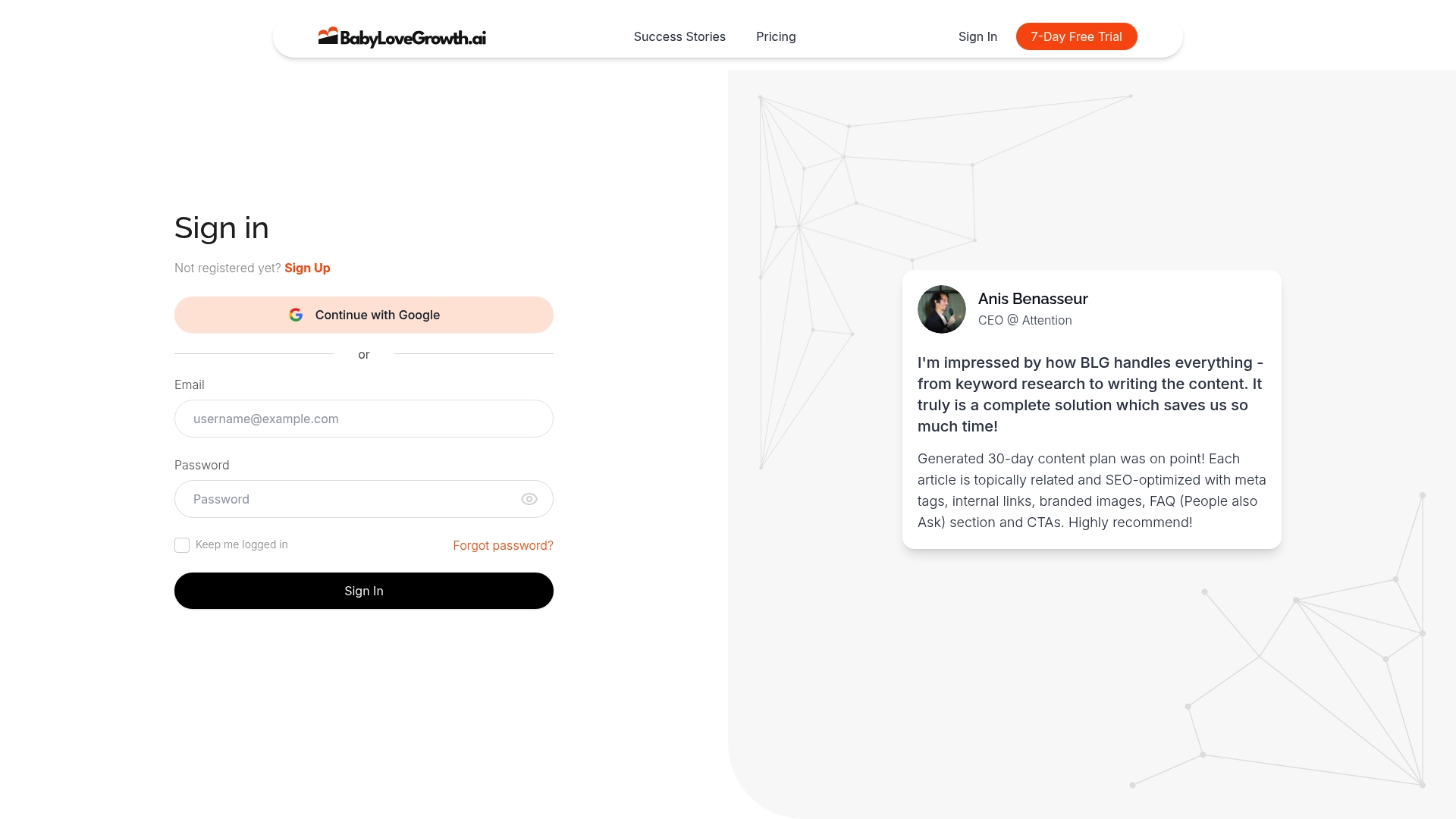
Ready to supercharge your digital marketing efforts? Don't let your content efforts go to waste. Act NOW to harness the power of AI and streamline your SEO processes. Visit Baby Love Growth AI today and unlock the full potential of your online presence!
Smart SEO,
Faster Growth!
Most Read Articles
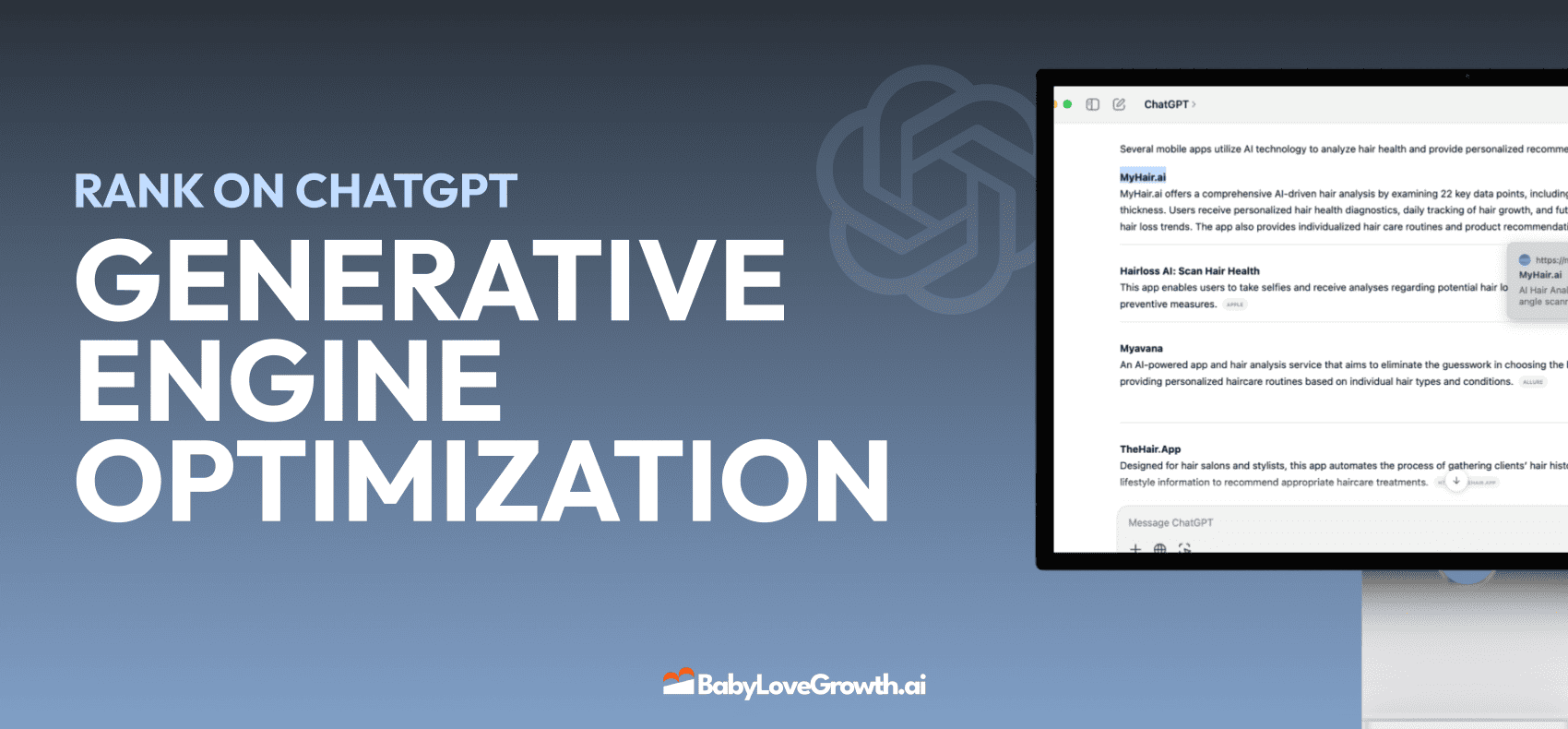
Generative Engine Optimization (GEO)
Learn how Generative Engine Optimization (GEO) helps your content rank in AI search engines like ChatGPT and Google AI. This comprehensive guide explains the differences between SEO and GEO, why it matters for your business, and practical steps to implement GEO strategies for better visibility in AI-generated responses.
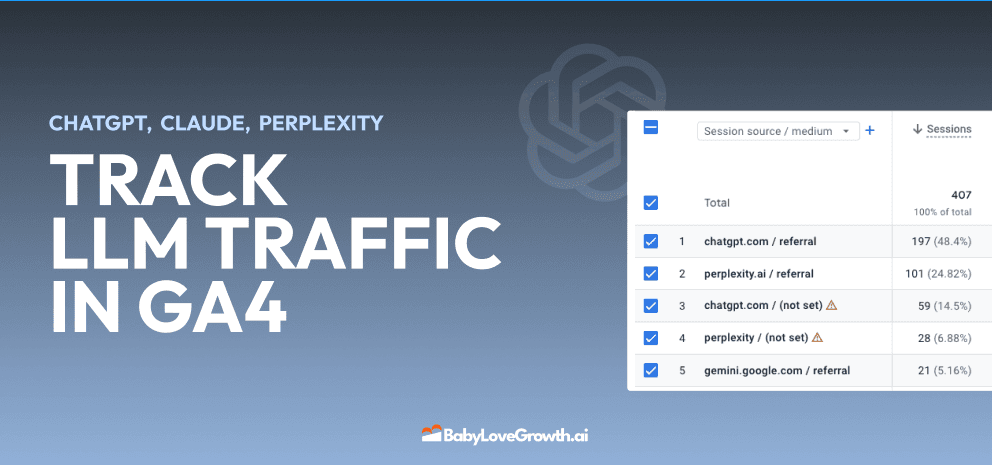
Track LLM Traffic in Google Analytics 4 (GA4)
Learn how to track and analyze traffic from AI sources like ChatGPT, Claude, Perplexity, and Google Gemini in Google Analytics 4. This step-by-step guide shows you how to set up custom filters to monitor AI-driven traffic and make data-driven decisions for your content strategy.
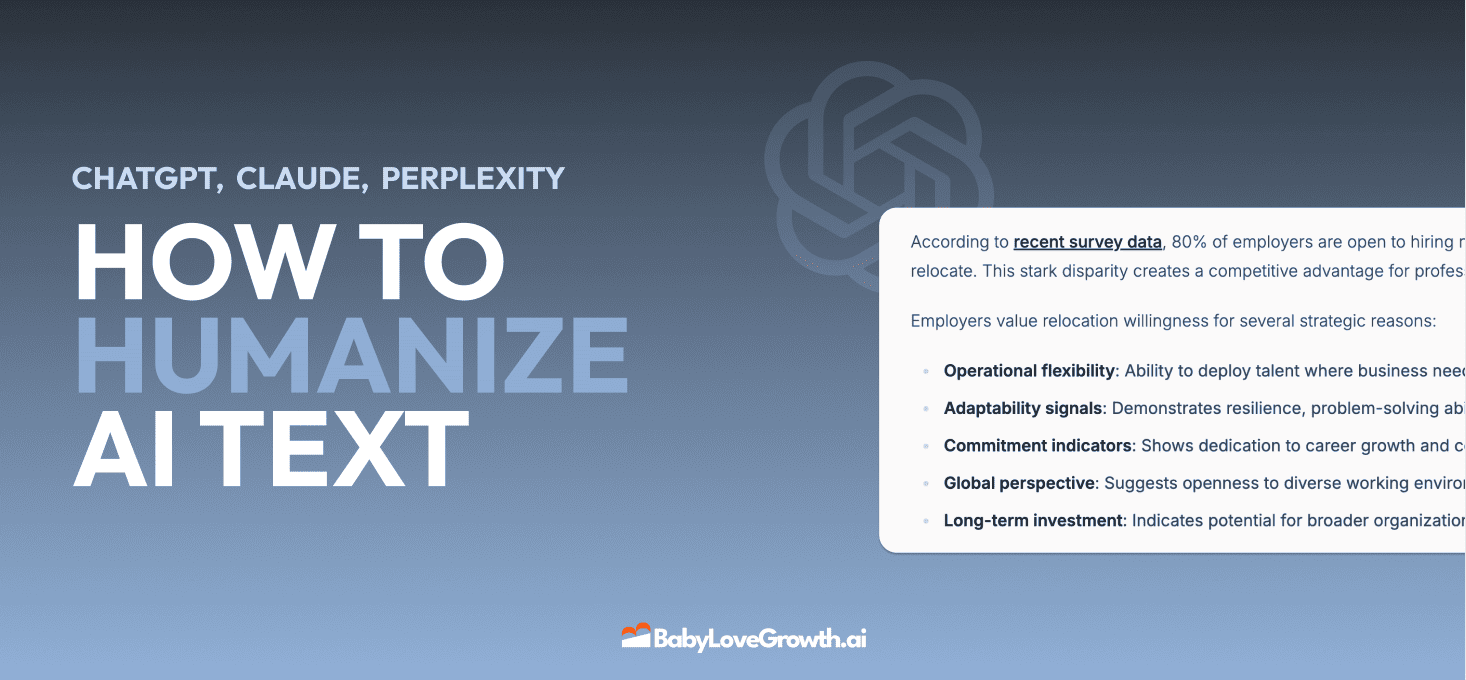
How to Humanize AI Text with Instructions
Learn practical techniques to make AI-generated content sound more natural and human. This guide covers active voice, direct addressing, concise writing, and other proven strategies to transform robotic text into engaging content.
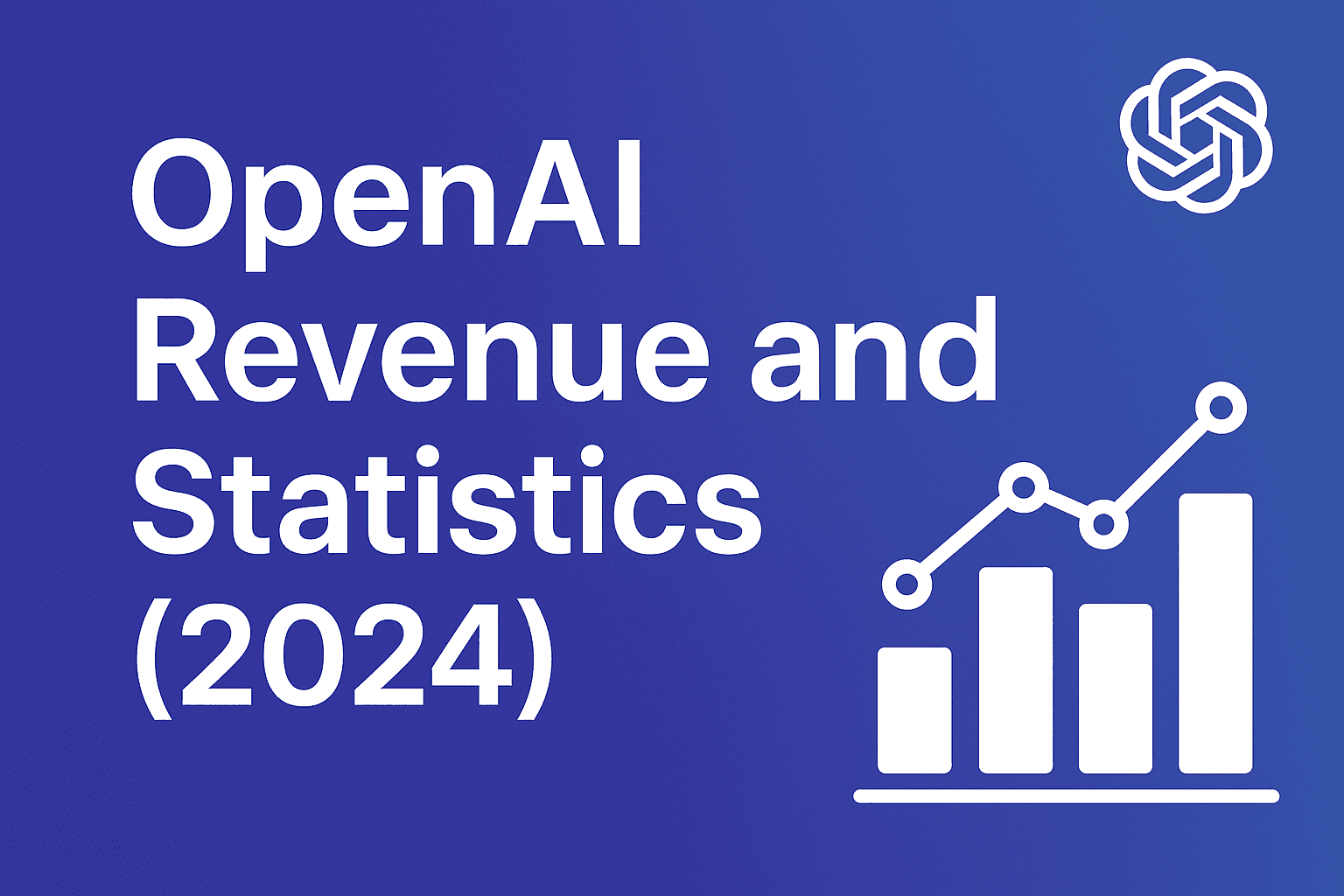
Open AI Revenue and Statistics (2024)
Comprehensive analysis of OpenAI financial performance, user engagement, and market position in 2023. Discover key statistics including $20B valuation, $1B projected revenue, and 100M+ monthly active users.